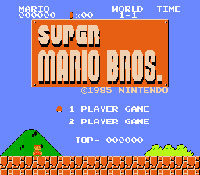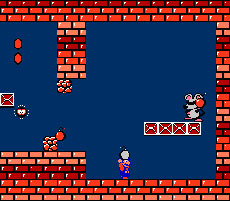|
Editorial: The History of Mario, Part 2Posted on Sun, Jun 20, 2004
Super Mario Bros.
Released: 1985
System: NES
1985. An unforgettable year full of unforgettable events, like the Michael J. Fox classic “Teen Wolf,” and…New Coke. Actually, to hell with all that—1985 is only memorable as a landmark year for the video game industry, as it was the year Nintendo released their Nintendo Entertainment System. Of course, the premier killer-app for the new video game system was Super Mario Bros. The brainchild of Shigeru Miyamoto, Super Mario Bros. was in large-part instrumental in exorcizing any doubts the public might have had over the future of the video game industry after the crash of 1982-83.
 Super Mario Bros. centered on, of course, Mario, who was first introduced in Donkey Kong and then starred in the original Mario Bros, before he became super. The plot in Super Mario Bros. was as simple as it was absolutely insane. Mario and his brother, Luigi (who was destined to take a backseat to his little brother for the rest of their gaming careers), are plumbers living in New York. When trying to fix a pipe one day, they got sucked into it and came out the other end in the Mushroom Kingdom, a land that is home to many strange creatures. Unfortunately, the Mushroom Kingdom is in disarray. The leader of the land, Princess Toadstool (who would much later be renamed Princess Peach), has been kidnapped by a large, fire breathing turtle named Bowser, king of the koopas. Being plumbers, the Mario Bros. are obviously the only living beings in the Mushroom Kingdom capable of undertaking the task of rescuing the princess (don’t even try to make any sense of this), and that’s exactly what they must do.
Super Mario Bros. centered on, of course, Mario, who was first introduced in Donkey Kong and then starred in the original Mario Bros, before he became super. The plot in Super Mario Bros. was as simple as it was absolutely insane. Mario and his brother, Luigi (who was destined to take a backseat to his little brother for the rest of their gaming careers), are plumbers living in New York. When trying to fix a pipe one day, they got sucked into it and came out the other end in the Mushroom Kingdom, a land that is home to many strange creatures. Unfortunately, the Mushroom Kingdom is in disarray. The leader of the land, Princess Toadstool (who would much later be renamed Princess Peach), has been kidnapped by a large, fire breathing turtle named Bowser, king of the koopas. Being plumbers, the Mario Bros. are obviously the only living beings in the Mushroom Kingdom capable of undertaking the task of rescuing the princess (don’t even try to make any sense of this), and that’s exactly what they must do.
By today’s standards, Super Mario Bros. is obviously a pretty basic game. There were eight worlds, and each world contained three levels and a castle to tackle. Although normal progression through the game’s levels is completely linier (no world maps with branching paths here), the most remarkable aspect of SMB was the gaggles of secret areas in each of the levels themselves. Most of those secrets only led to additional coins (100 of which would net you an extra life), but some would lead to warp pipes that allowed you to bypass entire worlds altogether. The greatest secret SMB held, however, was actually a bug that leads players into the “Minus World,” an underwater level that never ends—it just loops forever.
The gameplay was fairly barebones. Without power-ups Mario could only jump, either on enemies to dispatch them or to break bricks and blocks that held coins and power-ups. The only power-ups in the game were the super mushroom, which made regular, tiny Mario into the larger Super Mario; the fire flower, which gave Super Mario the ability to shoot fireballs; and the invincibility star, which (surprise!) made Mario briefly invincible.
While in hindsight the mechanics of the game were extremely simple, that didn’t stop Super Mario Bros. from taking the gaming industry by storm when it débuted, as it was more advanced than nearly anything seen before it; and even with its simple design, it’s still a fantastically fun game to this day. While Nintendo experienced awesome success with the first Super Mario Bros., it’s doubtful anyone could have foreseen just how successful the Mario franchise would eventually become.
Super Mario Bros. 2
Released: 1988
System: NES
Before we get to the game itself, let’s just get a little bit of trivia out of the way. The Super Mario Bros. 2 that we’re familiar with actually isn’t the “real” SMB2. The true sequel to Super Mario Bros. was only released in Japan, and was essentially the exact same game as the first (recycling the same gameplay and graphics), but with new and much more challenging levels. So challenging, in fact, that Nintendo decided it was too tough for the American market. So instead of releasing it here in the states, Nintendo took another Japanese game (titled Doki Doki Panic), replaced the four main characters with Mario, Luigi, Toad and Princess Toadstool, made a few other small, mostly audio/visual alterations, and released it here as Super Mario Bros. 2. Nintendo did eventually bring the real SMB2 over here in the form of “Super Mario Bros. The Lost Levels” on the Super NES compilation cartridge Super Mario All Stars, and also included the game as an unlockable extra on Super Mario Bros. DX for the GBC. Conversely, Japanese gamers were able to play America’s SMB2 when it was released there as “Super Mario Bros. USA.”
As you can probably imagine, considering that it was based on a completely unrelated Japanese game, Super Mario Bros. 2 was very different from SMB in almost every way. In fact, the very core of the game was literally flipped upside-down; instead of dispatching your enemies by simply jumping on their heads, you had to pick them up off the grown and chuck them at another enemy, and instead of jumping to hit boxes to get coins and other items, you uprooted them from the ground. Another big change was that you didn’t just play as Mario—at the start of each level, you could choose to play as either Mario, Luigi, Toad or Princess Toadstool, and they all had certain advantages (Luigi’s and Toadstool’s jumps would float in the air longer, Toad could pluck up items or dig in sand quickly, etc.).
 The story was another substantial change from the first game, but it was no less bizarre. On a picnic, Mario and the gang find a strange door in a cave that leads to a land called “Subcon,” where, apparently, dreams come true. Unfortunately the dream-granting majesty of the land has been corroded by a nefarious villain known as Wart, so Mario and the gang decide to put a stop to his evil ways and liberate this newly discovered world. Wait, what’s this? Wart? Yes, Wart, not Bowser. In fact, Super Mario Bros. 2 is one of the very few Mario games to never have Bowser make any appearance, not even a small cameo, but that doesn’t mean there’s a dearth of enemies. Although you won’t find any koopas or goombas in Subcon, SMB2 was still chock full of evil cronies just begging to be dispatched in the worst way. The game marked the introduction of some of the most popular Mario enemies destined to make recurring appearances, such as Shy Guys, Bob-ombs, and the egg spitting Birdos.
The story was another substantial change from the first game, but it was no less bizarre. On a picnic, Mario and the gang find a strange door in a cave that leads to a land called “Subcon,” where, apparently, dreams come true. Unfortunately the dream-granting majesty of the land has been corroded by a nefarious villain known as Wart, so Mario and the gang decide to put a stop to his evil ways and liberate this newly discovered world. Wait, what’s this? Wart? Yes, Wart, not Bowser. In fact, Super Mario Bros. 2 is one of the very few Mario games to never have Bowser make any appearance, not even a small cameo, but that doesn’t mean there’s a dearth of enemies. Although you won’t find any koopas or goombas in Subcon, SMB2 was still chock full of evil cronies just begging to be dispatched in the worst way. The game marked the introduction of some of the most popular Mario enemies destined to make recurring appearances, such as Shy Guys, Bob-ombs, and the egg spitting Birdos.
In 2001, SMB2 made a big return to the gaming world when Nintendo ported it to the Game Boy Advance as Super Mario Advance, and made it their leading launch title for the handheld system. While the immense level of quality and originality in SMB2 is unquestionable, that ultimately didn’t help it from becoming arguably the least popular installment in the series. However, Nintendo definitely remedied their slight falter with the next Super Mario Bros. game, while at the same time creating a true classic.
Index:
Part 1 - Overview
Part 2 - Super Mario Bros 1 + 2
Part 3 - Super Mario Bros 3 + World
Part 4 - Super Mario World 2 + 64
Part 5 - Super Mario Sunshine
Part 6 - Spin-Offs
Part 7 - Spin-Offs, Continued
Part 8 - Shigeru Miyamoto Biography
Posted By: Kris Pigna - 5927 Reads
Go Back |
Features Index |
Post About It
|